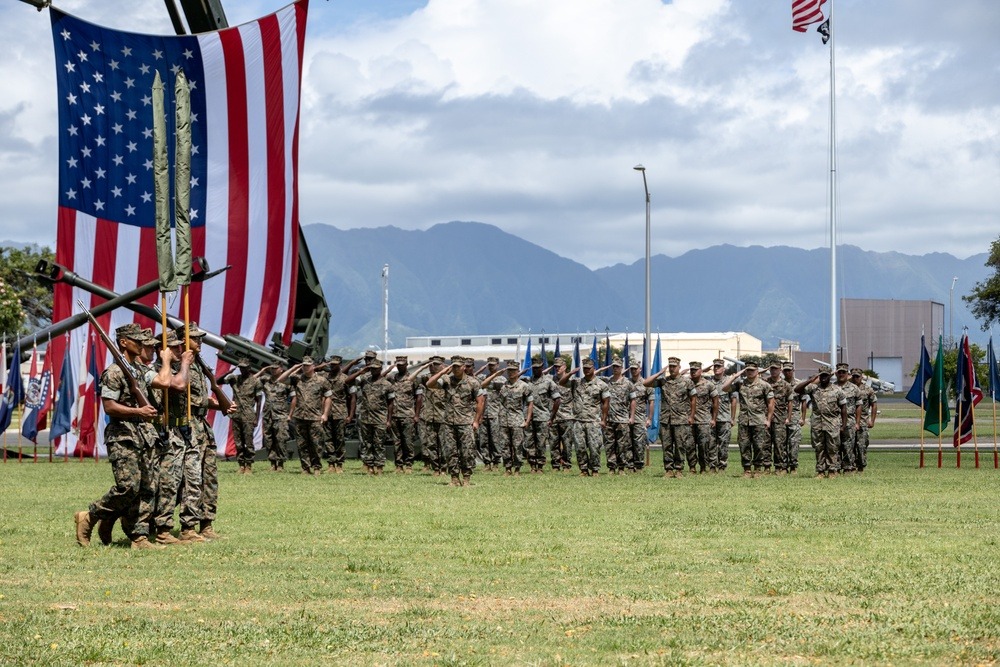
Release from 3rd Marine Division
************
MARINE CORPS BASE HAWAII, HI, UNITED STATES
05.26.2023
Story by 1st Lt. Anne Pentaleri
MARINE CORPS BASE HAWAII – 1st Battalion, 12th Marines cased its colors during the unit’s deactivation ceremony at Marine Corps Base Hawaii, May 26, 2023.
1st Battalion, 12th Marines activated on Sept. 1, 1942, as 4th Battalion, 12th Marines at Camp Elliot, California, as an artillery regiment in support of 3d Marine Division. After participating in a number of World War II campaigns, to include battles at Bougainville, Guam, and Iwo Jima, 1/12 underwent a brief period of deactivation before reactivating in support of the Far East Command’s maintenance of amphibious readiness capabilities during the Korean War.
The Marines of 1/12 saw the Vietnam War unfold from April 1965 to September 1969 while operating from their positions at Phu Bai, Da Nang, Cam Lo, Khe Sanh, and Camp Carroll. As U.S. forces kicked off the major raid known as Operation Thor on June 1, 1968, 1/12 enabled the regaining of control of the Demilitarized Zone through the provision of fire support and conduct of artillery raids.
In June 1971, at the conclusion of the Vietnam War, the Marines of 1/12 reported to Marine Corps Air Station Kaneohe Bay, Hawaii, where they have since been permanently stationed. In September 1994, after the battalion’s successful participation in operations Desert Shield and Desert Storm, 1/12 was reassigned to the 3d Marine Division as a part of III Marine Expeditionary Force. From August 2004 to November 2011, 1/12 participated in the Global War on Terror, deploying in support of operations Iraqi Freedom and Enduring Freedom. One such deployment to Al Anbar Province, Iraq, was under the command of now Maj. Gen. Stephen Liszewski, who served as 1/12’s battalion commander from 2006 to 2008, and is now the commanding general of Marine Corps Installations Pacific.
In recent years, 1/12 has been at the forefront of institutional change, leading the practical application of expeditionary advanced basing operations, experimentation with foraging concepts, and the employment of next-generation weapons systems. Most notably, operating in support of Large Scale Exercise 21, the battalion successfully employed the soon-to-be fielded Navy Marine Expeditionary Ship Interdiction System to fire the Naval Strike Missile aboard Pacific Missile Range Facility Barking Sands on Kauai, Hawaii, on Aug. 5, 2021. The missiles traveled over 100 nautical miles before reaching their target – a simulated adversary ship played by the ex-USS Ingraham, a retired Oliver Hazard Perry-class guided missile frigate. Similar operational mission profiles will allow Marine artillery to deny key maritime terrain and facilitate joint force maneuver.
“1st Battalion, 12th Marines spent the last two years at the forefront of force design and joint force integration,” said Lt. Col. Joseph Gill, commanding officer, 1st Battalion, 12th Marines. “We have made tremendous progress in the development of tactics, techniques, and procedures and set conditions for the fielding of the Navy Marine Corps Expeditionary Ship Interdiction System. The battalion’s efforts have increased the lethality of the 3d Marine Division and influenced the way we’ll fight for the foreseeable future.”
On May 26, 2023, the U.S. Marine Corps deactivated 1/12. The change took place in accordance with Force Design 2030’s modernization efforts. The battalion has played a valuable role in setting conditions for the 3d Marine Littoral Regiment, and future MLRs, to provide combat ready and lethal forces in the Indo-Pacific. 3d MLR and 12th Marines, which is scheduled to transition to an MLR in 2025, will provide ready and capable stand-in forces to the first island chain, bolstering the United States Indo-Pacific Command’s ability to support deterrence efforts and respond to potential crises with allies and partners.
“Deactivating a battalion of this nature and ensuring the deliberate transfer of personnel, facilities, and equipment is a tremendous undertaking,” said Maj. Ryan Capdepon, the executive officer of 1st Battalion, 12th Marines. “In true 1/12 fashion, our Marines and Sailors displayed professionalism, flexibility, and dedication in tackling the associated tasks. Concurrently, we continued to support numerous operational requirements and remain postured for potential contingency scenarios. I am proud of our team and the job they have done. Each one of them will be an asset to their next command.”






